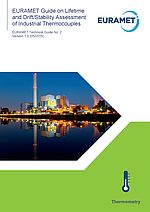Please type a search term (at least two characters)
Technical Guides
EURAMET has published several technical guides to give guidance on measurement practices in the specified fields of measurements.
All guides are listed below and are available for download as PDF version.
Get notified about updates of EURAMET Technical Guides
To receive information about updates of EURAMET Technical Guides please subscribe >>
Extrapolation of SPRT calibrations below the triple point of argon
The International Temperature Scale of 1990 (ITS-90) provides the basis for traceable temperature calibrations using Standard Platinum Resistance Thermometers (SPRTs) over the temperature range from the triple point of hydrogen, 13.8033 K to the freezing point of silver, 1234.93 K.
It is not practical to calibrate SPRTs of the long-stem design in sub-ranges of the ITS-90. Nevertheless, long-stem SPRTs are widely used as standards for calibrations carried out in baths of liquid nitrogen at approximately 77.3 K, for which a limited extrapolation of the SPRT calibration range is required.
Drawing on the results and experience from five National Measurement Institutes in Europe, the USA and Japan, these guidelines recommend that the standard uncertainty associated with the extrapolation of the calibration of SPRTs in the sub-range of the ITS-90 from the triple point of water to the triple point of argon, down to 77.3 K, is adopted as 0.15 mK (k = 1).
Lifetime and Drift/Stability Assessment of Industrial Thermocouples
The purpose of this guide is to outline the basic technical requirements for those laboratories undertaking the assessment on lifetime and calibration drift/stability of industrial base metal and noble metal thermocouples.
This document will assist the calibration laboratories, producers of thermocouples and end users with establishing the expected drift rates, or the lifetime of the calibration before recalibration (for noble metal types) or replacement (for base metal types) becomes necessary.
It is not the aim to replace or to harmonize the existing standards.
No. 2 | EURAMET Guide on Lifetime and Drift/Stability Assessment of Industrial Thermocouples
Use of GPS Disciplined Oscillators for Frequency or Time Traceability
The aim of this document is to provide guidelines on the use of GPS disciplined oscillators
as reference standards for frequency, time interval or time scale by accredited calibration
laboratories.
Frequency standards adjusted using the signals transmitted by the Global
Positioning System (GPS) navigation satellites, known as GPS disciplined oscillators
(GPSDOs), have become widely used in European calibration laboratories as reference
standards for time or frequency.
A GPSDO may provide traceability to Coordinated Universal Time (UTC) for frequency or time, provided that certain conditions are met. This document provides advice on how to satisfy these conditions when setting up a GPSDO as a laboratory reference standard, demonstrating traceability, and constructing an uncertainty budget.
No. 3 | EURAMET Technical Guide | Use of GPS Disciplined Oscillators
Conditions for the translation of EURAMET documents
EURAMET e.V. holds the copyright of all documents presented on this page. The EURAMET Secretariat may give permission for the translation.
Documents for download:



